Entrée Dishes, Harford County
From the USS Maryland Silver Service
First Entrée Dish |
Second Entrée Dish

Maker: Samuel Kirk & Sons (1815-1979)
Object: Entrée Dish, Harford County (1 of 2)
Date: 1906
Medium: Sterling Silver
Dimensions: Overall height, 2'; Overall diameter,
14"
Accession number: MSA SC 1545-0926-1
Harford County is represented by a pair of entrée dishes
which are engraved with scenes representing the colonial and
Revolutionary War era history of the county. Harford County
was created from Baltimore County in 1773 and named for
Henry Harford (c. 1759-1834), last Proprietary of Maryland.
He was a son of Frederick Calvert, 6th Lord Baltimore, but
because of his illegitimate birth did not inherit his
father's title.
Although each entrée dish is engraved with four different
scenes, the overall appearance of the dishes is identical.
The Great Seal and the Cruiser are each bordered by large
cornucopias containing fruits and vegetables. Sprays of oak,
chestnut, pine and stalks of wheat, corn, and goldenrod
surround the cornucopias.
Scenes across the top (left to right):
1.
Site of Old Baltimore Town and Tomb of James Philips
(number 76)
Alongside the Bush River, in 1676, a courthouse for the town of Baltimore was built. At the time, the land was part of Baltimore County but it is in present day Harford County. By 1693, the courthouse was moved, and the land became the Phillips’ family cemetery. A marble slab marking the final resting place of James Philips and his wife Martha is shown at the left of the Great Seal on one of the entree dishes.
Today, the land is part of Aberdeen Proving Grounds and is not accessible to the public.
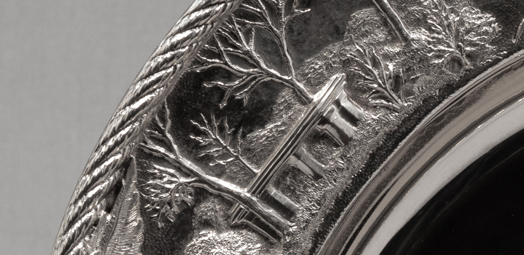 Site of Old Baltimore Town and Tomb of James Philips
Site of Old Baltimore Town and Tomb of James Philips
2. Great Seal of Maryland
3.
Tudor Hall
(number 75)
In 1821, celebrated English Shakespearian actor Junius Brutus Booth (father to President Lincholn assassin John Wilkes Booth) immigrated to America and settled in Harford County. Unable to purchase land, he rented a rural property in Bel Air and moved a small log cabin from a neighboring property there. In 1852, shortly before his death, Booth began construction on his estate, which he named Tudor Hall.
The house was patterned after the English cottages he had known as a boy, with latticed casement windows, window balconies, and a rambling floor plan. Tudor Hall was listed on the National Register of Historic Places in 1973.
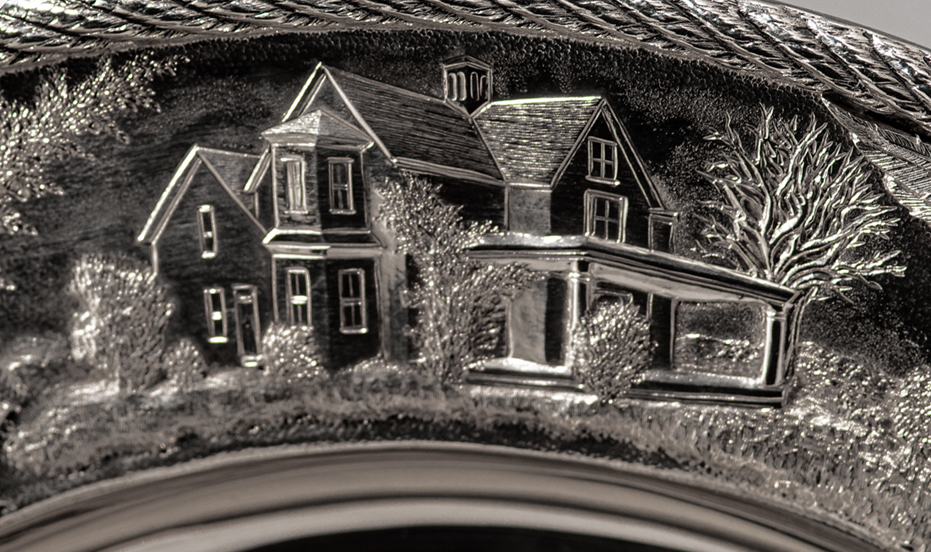 Tudor Hall
Tudor Hall
Scenes across the bottom (right to left)
1.
Courthouse at Belair
(number 78)
The first courthouse in Harford County was built in Bel Air between 1787 and 1790. It burned in 1858, and construction began that same year on a new courthouse, which was completed by 1859. The two story “I” shaped structure in Italianate style was designed by J. Crawford Neilson of Baltimore. Additions were added in 1904 in the Renaissance Revival style designed by John A. Dempwolf of Pennsylvania. Additional changes have occurred to the courthouse since, but the entree dish depicts the courthouse as it appeared in 1904.
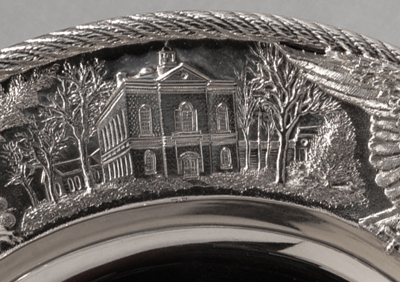 Courthouse at Belair
Courthouse at Belair
2. USS
Maryland Cruiser
3.
Old Post Road
(number 77)
The “old post road” was a popular historic route from Baltimore to points north. Also known as the “Philadelphia Road”, the path was likely first traversed by the indigenous peoples of Maryland before the arrival of English colonists. As the population of Maryland increased, the path became a more established and marked road for horses and carriages. Relay houses for replacement of horses were established at Bush and Havre de Grace, and inns dotted the road for travelers. Much of this historic road was incorporated into MD Route 7 and U.S. Route 40.
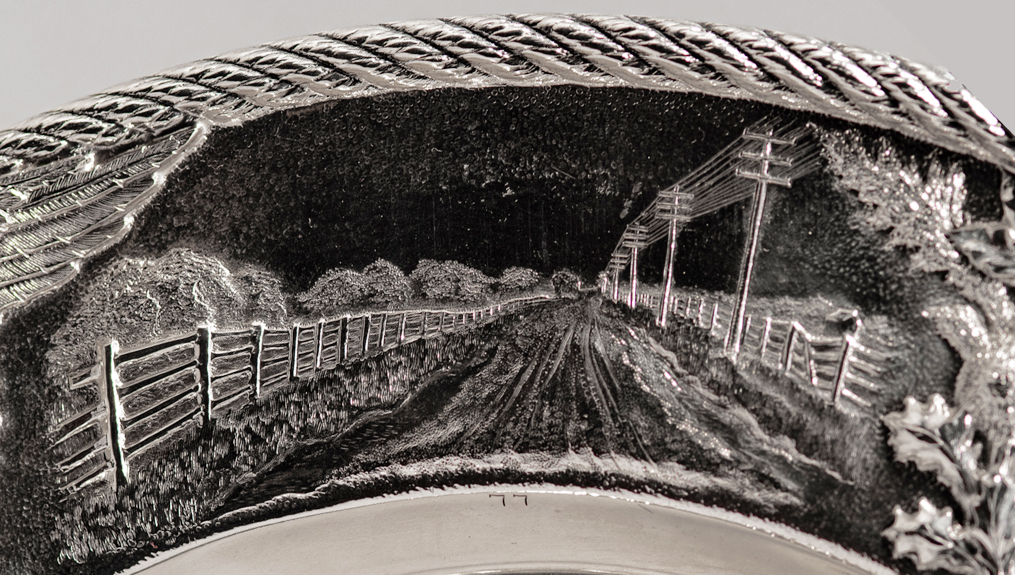 Old Post Road
Old Post Road
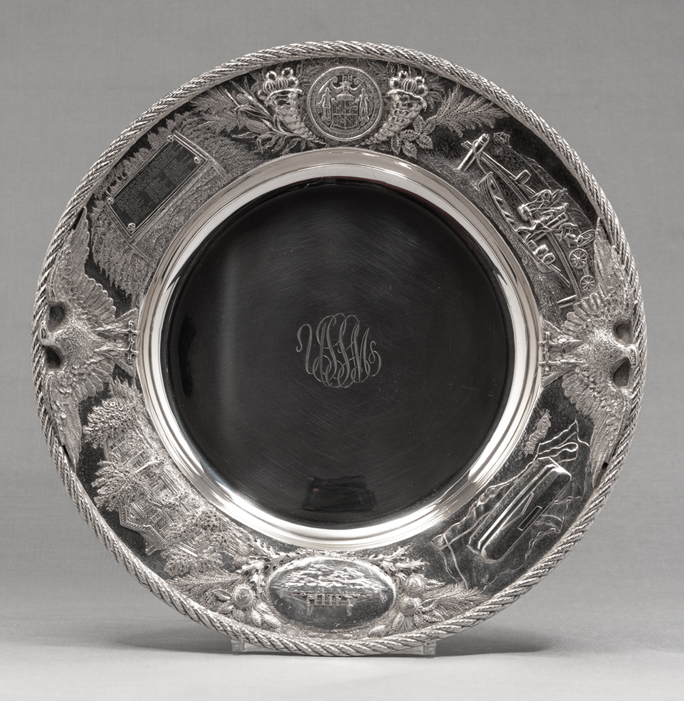
Maker: Samuel Kirk & Sons (1815-1979)
Object: Entrée Dish, Harford County (2 of 2)
Date: 1906
Medium: Sterling Silver
Dimensions: Overall height, 2'; Overall diameter,
14"
Accession number: MSA SC 1545-0926-2
Scenes across the top (left to right):
1.
Monument at Bush
(number 79)
Near Abingdon, Maryland is a historical marker that commemorates the “Bush Declaration” which was signed on March 22, 1775. It was signed by 34 elected men a few weeks before the Battles of Lexington and Concord and is reflective of the strong patriot sentiment rising in the colonies. To honor the signers of this declaration, a tablet monument was erected on the spot of the county seat where the “Bush Declaration” was signed.
 Monument at Bush
Monument at Bush
2. Great Seal of Maryland
3.
Shipping Flour from Bush to Boston
(number 80)
In response to the Boston Tea Party, Lt.-Gen. Thomas Gage, shut down the towns’ harbor, bringing all shipping and commerce to a stop. Realizing the dire situation, members of the Boston Committee of Correspondence appealed to other colonies for assistance. The Maryland Convention met in Annapolis and agreed that each county would contribute in sending relief to Boston during the blockade. In June 1774, Harford County adopted a resolution to, “[...] send relief to the poor and distressed inhabitants of Boston, to enable them to persevere in defense of the common cause." This scene on the entree dish shows flour being loaded at Bush for shipment to Boston.
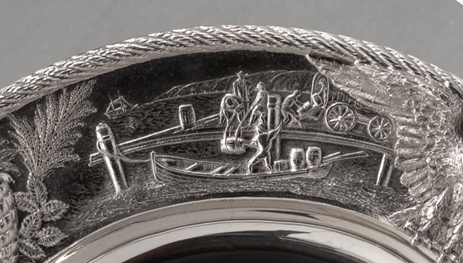 Shipping Flour from Bush to Boston
Shipping Flour from Bush to Boston
Scenes across the bottom
(right to left)
1. Sion Hill
(number 82)
“Sion Hill” was first constructed c. 1785 by the Reverend John Ireland, who intended it to be a private seminary school. He sold the unfinished property in 1795 to Gideon Denison, who’s daughter married Commodore John Rodgers. The Rogers inherited the property and completed the house. Sion Hill continued to descend through the Rogers family, including numerous generations of naval leaders. It was added to the National Register of Historic Places in 1990.
This is the only home shown on the service that is directly associated with the Navy. Commodore John Rodgers, who is featured on one of the punch cups, was the captain of the first USS
Maryland.
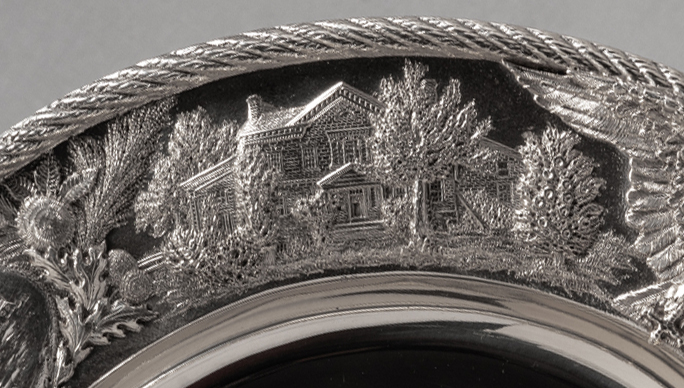 Sion Hill
Sion Hill
2. USS
Maryland Cruiser
3.
Admiral Cockburn’s Snuff Box
(number 81)
During the War of 1812, Havre de Grace was attacked by the British and John O’Neill, the lighthouse keeper at Point Concord, was taken prisoner. His daughter went aboard the frigate H.M. “Maidstone” and personally negotiated his release. She reportedly received a tortoise shell box from British Admiral Sir George Cockburn as a gift for her bravery, which is depicted on the silver service.
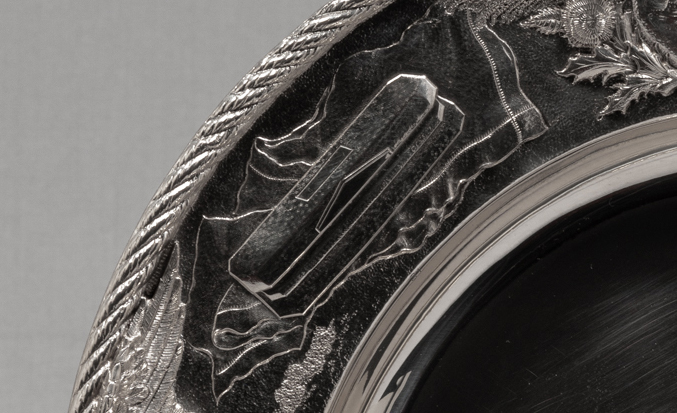 Admiral Cockburn’s Snuff Box
Admiral Cockburn’s Snuff Box
|
This web site is presented for reference purposes under the doctrine of fair use. When this material is used, in whole or in part, proper citation and credit must be attributed to the Maryland State Archives. PLEASE NOTE: The site may contain material from other sources which may be under copyright. Rights assessment, and full originating source citation, is the responsibility of the user.
|
©
Copyright August 06, 2024 Maryland State Archives









